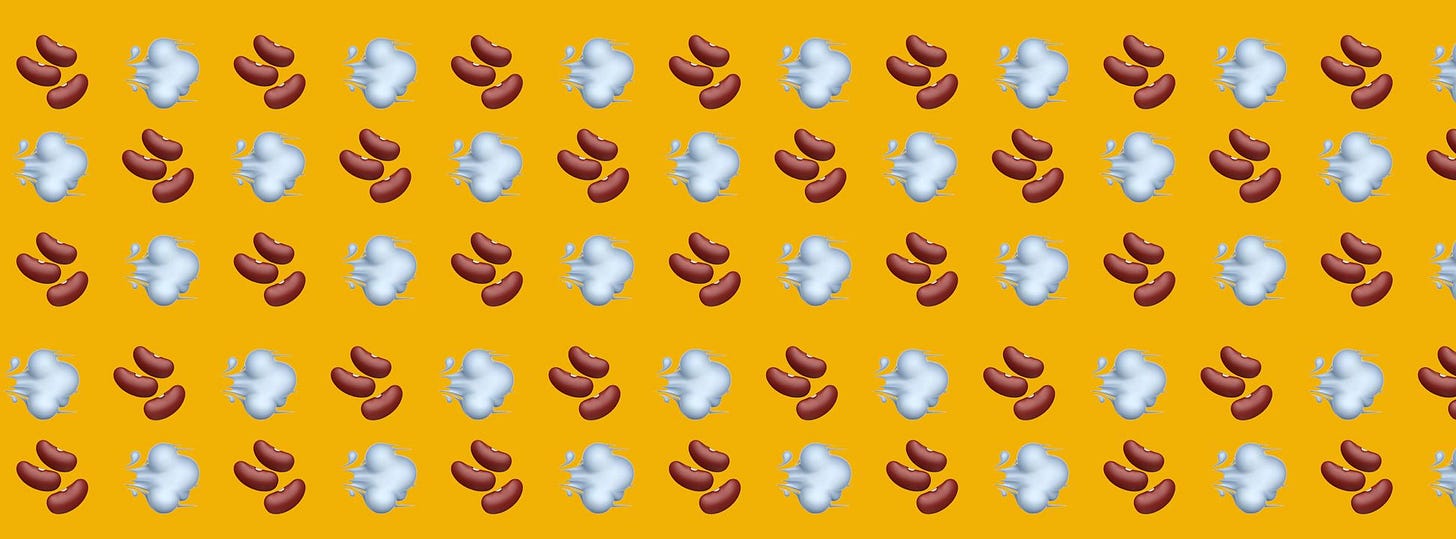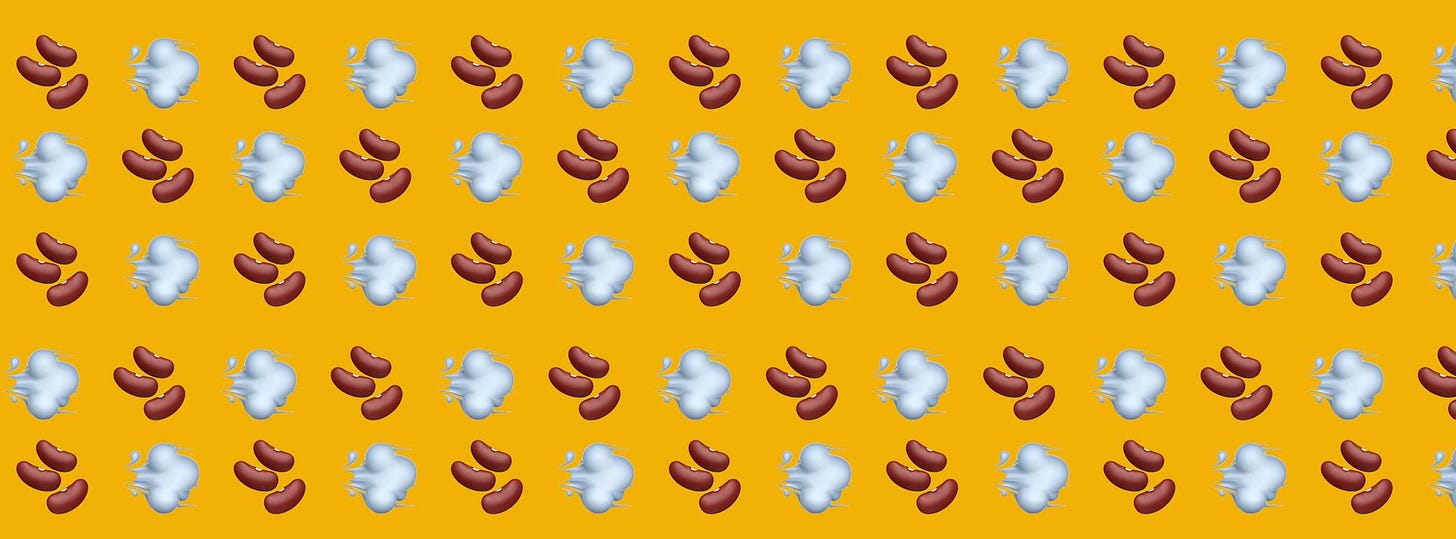Bean Science Part II
🫘💨 Beans and the Science of Flatulence.
Before we jump into the second part of Bean Science, here’s a quick recap from Part I. I apologize in advance for the heavy use of emojis 🫘💨.
Beans turn hard on drying, and this contributes to longer cooking times.
Pectin is a complex carbohydrate found in plant cells and is one of the significant contributors to hardness in dried beans.
Salt, baking soda, citric acid (lemon juice or lime juice), and sodium citrate are effective agents that can change the chemistry of pectin and help beans cook faster and turn creamy and tender.
Us humans can’t digest dietary fiber from plants. However, our naturally present gut bacteria can eat these fibers up and, in turn, produce flatus (aka stinky farts). (We’re going to talk a lot about this today.)
While beans remain popular (and tasty), they are notoriously associated with lectin side effects and flatulence (I promised you we’d dive straight into farts in this part II).
Let’s begin with lectins.
Lectins are a type of protein found in plants (especially dried beans) that love binding carbohydrates. In plants, lectins act as a defense mechanism to protect the plant from harmful microbes and predators. When exposed to a microbe, the lectin proteins can recognize and attach to carbohydrates present in the predators and activate the plant's immune system. In raw, uncooked, and undercooked beans, especially kidney beans, lectins become a problem and can cause undesirable symptoms like nausea, vomiting, stomach upset, and even diarrhea. Lectins like to bind carbohydrates, and this becomes a problem because they attach to the carbohydrates present on the surface of our blood cells, which makes blood cells aggregate. In addition, lectins can interfere with the absorption of certain minerals like calcium, phosphorus, and zinc in animal and cell studies. However, while all of these reasons might seem like a reason to avoid eating beans altogether, it’s infrequent that someone intentionally eats raw and uncooked beans. Now, I can see undercooked beans being a problem and the solution to that is easy, cook your beans properly all the way through until they are tender. Cooking destroys lectins. The combination of heat and moisture destroys these proteins, and if the beans are cooked properly, the side effects from lectins should be a non-issue. You can apply one of the cooking methods from Part I to prepare your beans. Soaking beans before cooking also helps reduce the load of lectins, so that’s another excellent reason to soak your beans before cooking.
Flatulence 💨
I’ve got a few friends who shall remain anonymous but avoid eating beans at all costs when we go out to dinner or if I have them over and serve them beans. It’s not lectins or allergies but the possibility of flatulence that makes them stay clear of beans. (I’ve even resorted to keeping a jar of Beano on the table for them.)
Let’s quickly discuss why eating beans leads to gassiness and then get into a few ways to reduce and avoid those spicy airy moments. Beans are a rich source of fiber and RFOs - the Raffinose Family of Oligosaccharides (oligosaccharides are carbohydrates that are made up of 3 to 10 simple sugars) that include raffinose, stachyose, verbascose, and melibiose. Our bodies don’t synthesize the necessary enzymes to break down these carbohydrates, but the bacteria in our guts can. In the process, these bacteria produce gases, and the rest is a spicy gassy story.
There are two ways to tackle this issue.
Remove as many of those indigestible RFOs carbohydrates before or during cooking.
If you didn’t get a chance to remove those carbohydrates from the beans and you ate those beans, remove or treat them in your body.
There are a couple of ways to remove most of these carbohydrates before or during cooking. Soaking beans in water or brining them helps soften the beans and hydrate them. Many of those indigestible carbohydrates leach out into the soaking and brining water during this process. Discarding that water after soaking or brining is vital to reduce the load of these substances. If you cook beans in water or add baking soda, that will also help pull out these gas-producing substances from the beans into the water. Remember, you must discard the cooking water to reduce the chances of flatulence. If all those substances leached out into the cooking water and you used the same water to cook with, it will not be efficient. Here’s another point to remember, all beans are not created equally. Some beans contain more or less of these gas-producing substances, and not all beans respond similarly. So you might experience little or no bloating; it will depend on the bean and how much of these substances they carry. The reality is that none of these methods are 100% efficient, but they get us closer to the goal.
(Use the same soaking, brining, and cooking methods listed in Part I)
Alpha-Galactosidase, Kombu, Beano, and More
There’s another way to deal with these RFOs, and that is to use an enzyme called alpha-galactosidase on them. All members of the RFOs contain the sugar galactose in them, and the enzyme alpha-galactosidase can cut this sugar out and, in turn, helps break these RFOs into smaller units that are easily digestible; I've and reduces the risk of flatulence. One way to achieve this is to add kombu/kelp (a type of seaweed) to beans. Beano, the pill that’s taken when eating a meal of beans, contains this enzyme and works on the same principle.
You can use kombu (and even Beano to attack these RFOs). This method uses kombu and is based on cooking the kombu and the beans together; I've tried it a couple of times but found that it doesn’t work as well. Here’s why. Alpha-galactosidase is an enzyme, and it works best between temperatures of 99 to 140F/37 to 60C. The enzyme loses its activity at 176F/80C, and if you cook beans with kombu and boil them together, the mixture crosses the boiling point of water, and the enzyme will no longer be functional and able to do its job.
There’s another way to go about using kombu. I will warn you that it’s an extra time-consuming step to add to your cooking (I rarely do this).
Add a 6 in/15 cm sheet of kombu + 4 ½ cups/1 L of water + 2 cups of drained, soaked beans. Soak the beans at 140F/60C for 2 hours. Discard the liquid and use the beans in your recipe.
To maintain the temperature, you can either use a sous vide device or an instant pot. The kombu will fall apart, discard the water, and cook the beans. You’ll notice the beans might appear slightly soft after this. The warm temperature will partially cook the beans, so adjust your cooking time when you move to the next (and final stage of cooking). A note on the Instant Pot "Keep Warm" setting: According to the Instant Pot’s manual, the keep warm setting ranges between 145°F/63°C to 172°F/78°C. Admittedly, I don’t use my Instant pot very often because the higher end of that temperature range is very close to 176F/80C, but this has the potential to work. If I don't have kombu on hand, I add a crushed Beano pill, which works nicely.
Sprouting
Another option is to germinate/sprout your beans and then cook them. In India and many other parts of Asia and the Middle East, beans are soaked in plain water (I use filtered water) until they just begin to germinate and show their tiny roots (it takes about 1 to 2 days for beans to sprout, depending on how warm the room is). During this stage, the RFOs inside the seed are quickly used by the bean for its growth needs. Another bonus is that sprouted beans cook much faster. Expect a slight difference in taste when using sprouted beans in your recipes; their biology changes and, subsequently, their flavor and texture.
If all else fails, light a few candles and crack the windows open to save your loved ones from a gassy fury.
🫘🫘🫘🫘🫘🫘🫘🫘🫘🫘🫘
BEAN Q + A
I received lots of questions from you on beans, and here are answers to some of the most popular ones.
"Should I brine my beans and then cook them with baking soda?"
I recommend using one or the other method, don't do both. If you use both methods, the cooked beans might become very mushy. If you're making a bean pureée, a smooth, creamy bean soup, or hummus, this might be okay, but for all other purposes, if the beans need to hold their shape, stick to one or the other method.
"Will brining beans with salt and baking soda increase sodium levels?"
It will not. After beans are brined, their brining water is discarded, and the sodium gets tossed out in the water. The amount that does get into the bean’s pectin is very tiny (Cook’s Illustrated looked into this for brining different types of foods and found a minimal amount of sodium in brined beans).
“I’ve seen people use black tea for cooking chole. Do tannins make beans cook faster?”
Black tea adds color and a mild savory flavor to chickpeas in the dish, chole. Tannins do not decrease the cooking time of beans, and if this were true, then beans would cook faster; I’ve not noticed a time difference when I’ve compared this. Coincidentally, some bean varieties with dark coats, like kidney beans, contain tannins, and if tannins helped reduce the cooking time, these beans would need little to no help cooking.
"Will brining or using baking soda when boiling beans reduce the incidence of flatulence?"
It depends on the type of bean and how the beans were processed. Different varieties of beans contain different amounts of RFOs. In both brining and boiling, the RFOs are still present; they’ve only changed their location and moved from the bean into the water.
"Are coffee beans legumes?"
A coffee bean is not technically a bean and is two pits present inside the fruit, and the plant is a member of the Madder family of plants. Tamarind, on the other hand, is a legume.
“Should I use filtered water when soaking, brining, and cooking beans?”
I live in a city where the water is very hard. I use filtered water when I’m soaking and cooking beans, but if I’m brining them in a solution of salt and baking soda, I don’t bother. The amount of sodium is high enough in a brining solution to counteract the negative effects of calcium and magnesium in hard water. I recommend testing this out where you live because water hardness levels vary by location. If you don’t trust tap water, use filtered water. You do not need to use distilled water; that will be overkill.



